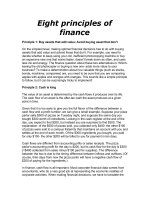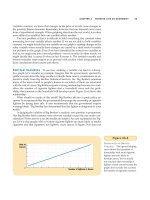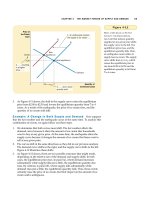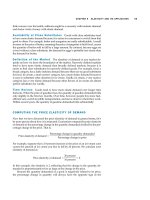Tài liệu Eight principles of finance pdf
Bạn đang xem bản rút gọn của tài liệu. Xem và tải ngay bản đầy đủ của tài liệu tại đây (66.01 KB, 3 trang )
Eight principles of
finance
Principle 1: Buy assets that add valua; Avoid buying asset that don't
On the simplest level, making optimal financial decisions has to do with buying
assets that add value and advoid those that don't. For example, you need to
decide whether to keep using your old, inefficient photocopying machine or buy
an expensive new one that works faster, doesn't break down as often, and uses
less ink and energy. The finance question about these two alternatives is: Which-
keeing the old photocopier or buying a new one- adds more value to your
business? To make a determination about hou valuable things (such as stocks,
bonds, machines, companies) are, you need to be sure that you are comparing
apples with apples and oranges with oranges. This sounds like a simple principle
to follow, but it can be surprisingly tricky to implement!
Principle 2: Cash is king
The value of an asset is determined by the cash flows it produces over its life.
The cash flow of an asset is the after-tax cash the asset produces at a given
point in time.
Given that it is too early to give you the full flavor of the difference between a
cash flow and a profit number, we can give a small example. Suppose your pizza
parlor sells $500 of pizzas on Tuesday night, and suppose the same day you
bought $300 worth of indredients. Looking in the cash register at the end of the
day, you expect to find $200, but instead you are surprised to find $300. The
explanation: of the $500 of pizzas sold, you collected only $400- the other $100
of pizzas were sold to a campus fraternity that maintains an account with you and
settles at the end of each month. Of the $300 ingredients you bought, you paid
for only $100- the other $200 will be billed to you for payment in ten days.
Cash flows are different from accounting prfits or sales receipts. The pizza
parlor's accounting profit for the day is $200, but its cash flow for the day is $300
(=$400 collected from sales minus $100 paid for supplies). The difference
between the two is due to the timing difference between inflows and outflows. (Of
course, then days from now the pizza parlor will have a negative cash flow of
$200 of paying for the ingredients.)
In finance, cash flow is all-important. Most corporate financial data comes from
accountants, who do a very good job at representing the economic realities of
corporate activities. When making financial decisions, we have to translate the
accounting data to their cash equivalents. Much of finance involves first
translating accounting information into cash flows.
Principle 3: The time dimension of financial decisions is important
Many financial decisions have to do with comparing cash flows at different points
in time. As an example: you pay for that new photocopy machine today (a cash
outflow), but you save money in the future (a cash inflow).Finance has to do with
correctly dealing with this time dimension of cash flows.
Principle 4: Know how to compute the cost of financial alternatives
Financial alternatives are often bewildering: is it more expensive to buy or lease
a photocopier? When your credit card charges you "daily interest," it is more or
less expensive than the bank loan, which charges you "monthly interest?" In
making financial decisions, you need to know how to compute the cost of two or
more competing alternatives.
Principle 5: Minimize the cost of financing
Many financial decisions have to do with choosing the right alternative. Should
you finance that photocopier with a loan from the dealer or with a loan from the
bank? Should you invest in a real estate project or leave your moneyin the stock
market?
Choosing the right financial alternative is, in many cases, a decision made
separately from the investment decision: You've decided to purchase the opier
(the investment decision), and now you have to choose whether to finance it
through a bank loan or through the dealer's "zero interest financing" (the
financing decision).
Principle 6: Take risk into account
Many financial alternatives cannot be compared directly without taking into
account their risk. Should you take money out of the bank and inest it in the stock
market? On the one hand, people who invest in the stock market on average
earn more than those who leave their money in the bank. On the other hand, a
bank deposit is safe, whereas a stock market investment is much leass safe
(riskier).
"Risk" is the magic word in finance.
Principle 7: Markets are efficient and deal well with information
Financial markets are awash in information. In making a financial decision, how
can we possibly know or obtain all the information we need to make a sensible,
well-informed decision? The bad news is that we probably can't incorporated all
available information into our decsion-making process. The good news is that we
may not have to: The confluence of many market participants striving to make
use of what information they have leads markets to work to eliminate profitable
opportunities. In many caseses, financial markets work so well thatwe can't add
anything to their information-gathering abilities. In short: It may well be that the
stock market's valuation of XYZ stock is correct given all the information available
about the stock. This market efficiency can simplify the wa you think about assets
and their prices when making financial decisions.
Principle 8: Diversification is important
"Don't put all your eggs in one basket." The financial equivalent of this hackneyed
expression is: Diversify the assets you hold; don't hold just a few stocks or
bonds- buy a porfolio.
Simmon Benninga, Principles of Finance with Excel









